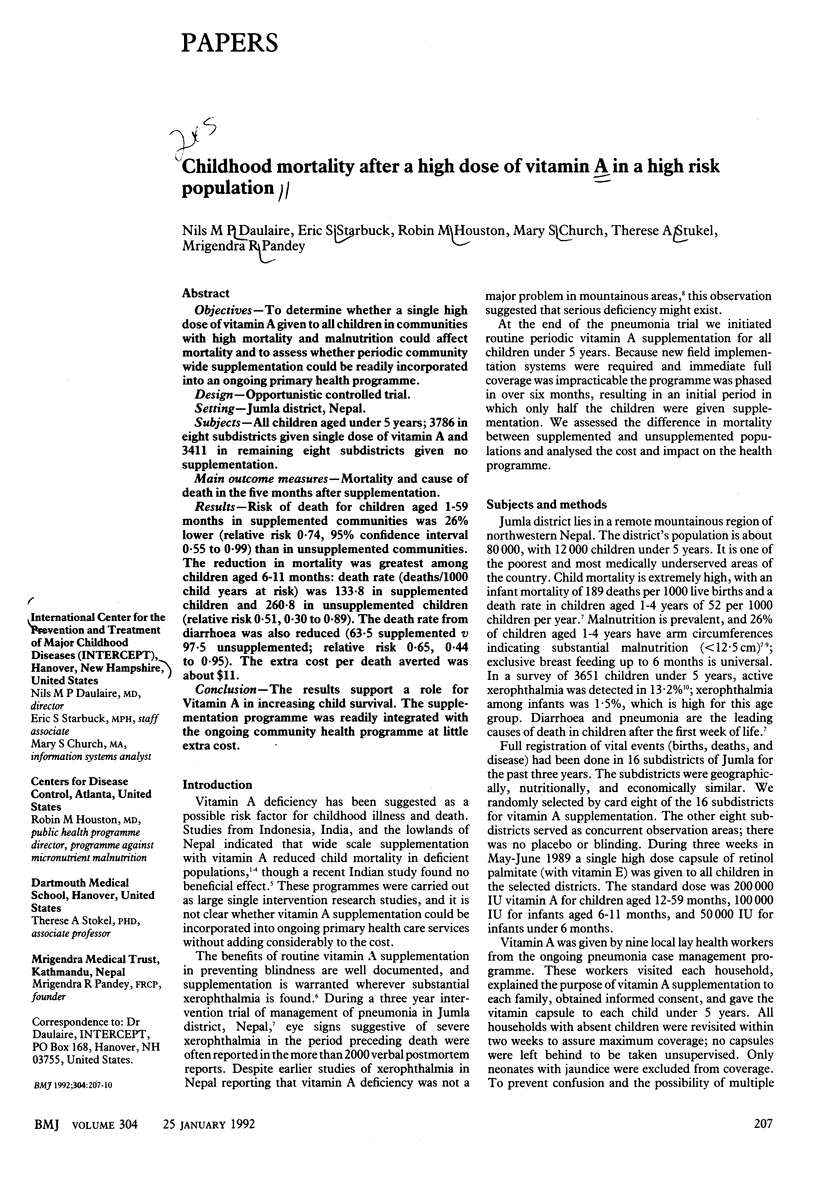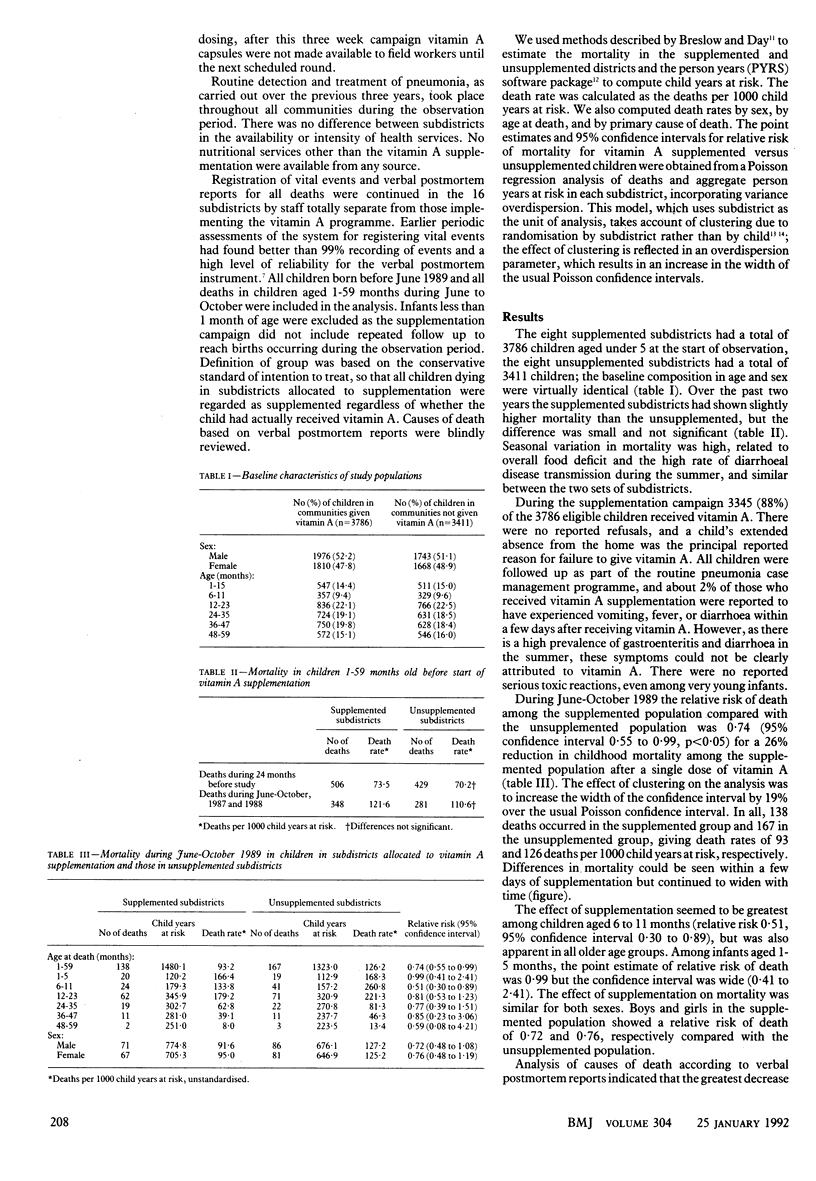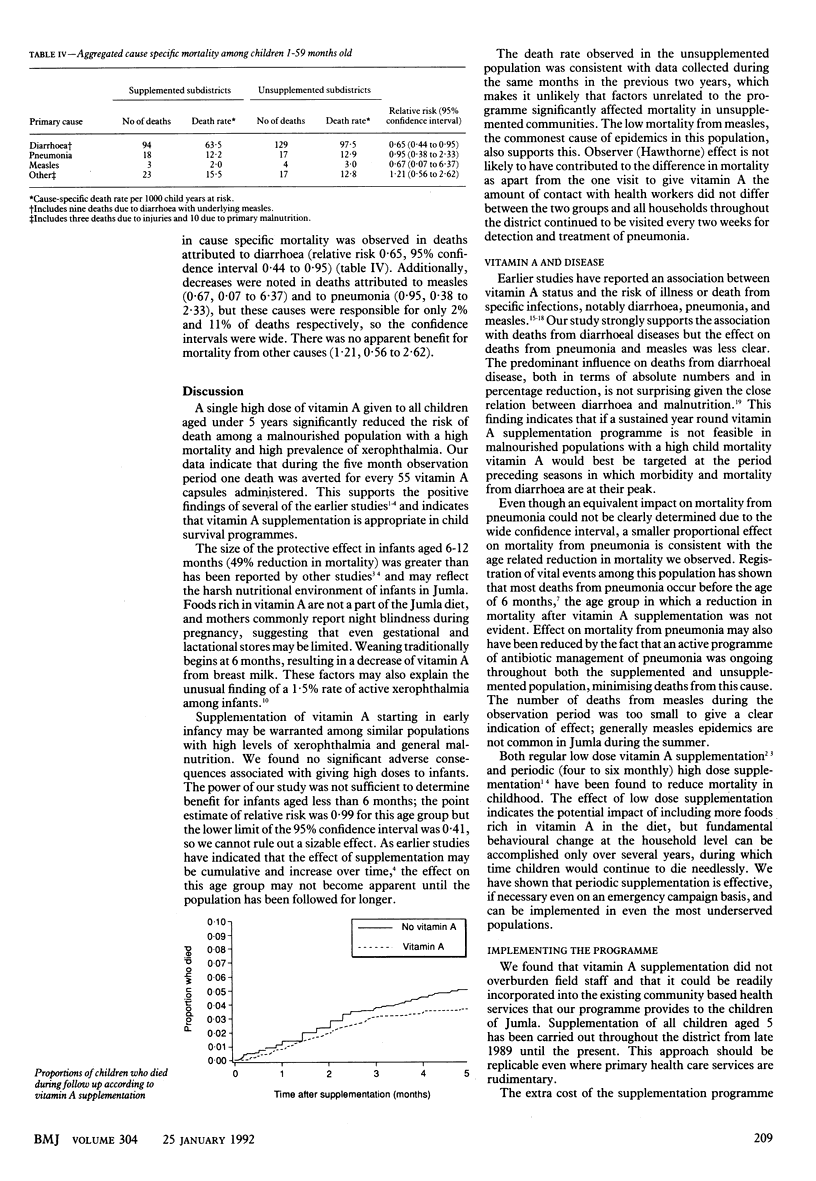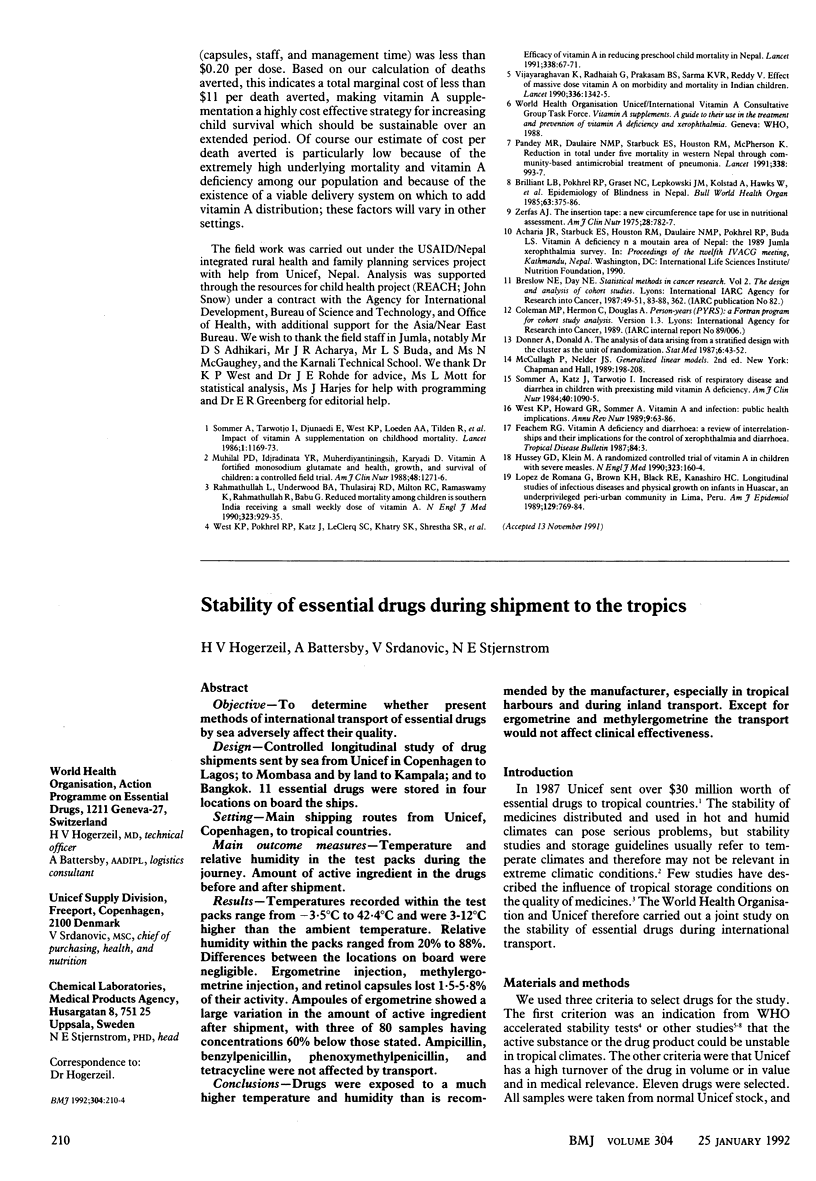Abstract
OBJECTIVES--To determine whether a single high dose of vitamin A given to all children in communities with high mortality and malnutrition could affect mortality and to assess whether periodic community wide supplementation could be readily incorporated into an ongoing primary health programme. DESIGN--Opportunistic controlled trial. SETTING--Jumla district, Nepal. SUBJECTS--All children aged under 5 years; 3786 in eight subdistricts given single dose of vitamin A and 3411 in remaining eight subdistricts given no supplementation. MAIN OUTCOME MEASURES--Mortality and cause of death in the five months after supplementation. RESULTS--Risk of death for children aged 1-59 months in supplemented communities was 26% lower (relative risk 0.74, 95% confidence interval 0.55 to 0.99) than in unsupplemented communities. The reduction in mortality was greatest among children aged 6-11 months: death rate (deaths/1000 child years at risk) was 133.8 in supplemented children and 260.8 in unsupplemented children (relative risk 0.51, 0.30 to 0.89). The death rate from diarrhoea was also reduced (63.5 supplemented v 97.5 unsupplemented; relative risk 0.65, 0.44 to 0.95). The extra cost per death averted was about $11. CONCLUSION--The results support a role for Vitamin A in increasing child survival. The supplementation programme was readily integrated with the ongoing community health programme at little extra cost.
Full text
PDF



Selected References
These references are in PubMed. This may not be the complete list of references from this article.
- Brilliant L. B., Pokhrel R. P., Grasset N. C., Lepkowski J. M., Kolstad A., Hawks W., Pararajasegaram R., Brilliant G. E., Gilbert S., Shrestha S. R. Epidemiology of blindness in Nepal. Bull World Health Organ. 1985;63(2):375–386. [PMC free article] [PubMed] [Google Scholar]
- Donner A., Donald A. Analysis of data arising from a stratified design with the cluster as unit of randomization. Stat Med. 1987 Jan-Feb;6(1):43–52. doi: 10.1002/sim.4780060106. [DOI] [PubMed] [Google Scholar]
- Hussey G. D., Klein M. A randomized, controlled trial of vitamin A in children with severe measles. N Engl J Med. 1990 Jul 19;323(3):160–164. doi: 10.1056/NEJM199007193230304. [DOI] [PubMed] [Google Scholar]
- Lopez de Romaña G., Brown K. H., Black R. E., Kanashiro H. C. Longitudinal studies of infectious diseases and physical growth of infants in Huascar, an underprivileged peri-urban community in Lima, Peru. Am J Epidemiol. 1989 Apr;129(4):769–784. doi: 10.1093/oxfordjournals.aje.a115192. [DOI] [PubMed] [Google Scholar]
- Muhilal, Permeisih D., Idjradinata Y. R., Muherdiyantiningsih, Karyadi D. Vitamin A-fortified monosodium glutamate and health, growth, and survival of children: a controlled field trial. Am J Clin Nutr. 1988 Nov;48(5):1271–1276. doi: 10.1093/ajcn/48.5.1271. [DOI] [PubMed] [Google Scholar]
- Pandey M. R., Daulaire N. M., Starbuck E. S., Houston R. M., McPherson K. Reduction in total under-five mortality in western Nepal through community-based antimicrobial treatment of pneumonia. Lancet. 1991 Oct 19;338(8773):993–997. doi: 10.1016/0140-6736(91)91847-n. [DOI] [PubMed] [Google Scholar]
- Rahmathullah L., Underwood B. A., Thulasiraj R. D., Milton R. C., Ramaswamy K., Rahmathullah R., Babu G. Reduced mortality among children in southern India receiving a small weekly dose of vitamin A. N Engl J Med. 1990 Oct 4;323(14):929–935. doi: 10.1056/NEJM199010043231401. [DOI] [PubMed] [Google Scholar]
- Sommer A., Katz J., Tarwotjo I. Increased risk of respiratory disease and diarrhea in children with preexisting mild vitamin A deficiency. Am J Clin Nutr. 1984 Nov;40(5):1090–1095. doi: 10.1093/ajcn/40.5.1090. [DOI] [PubMed] [Google Scholar]
- Vijayaraghavan K., Radhaiah G., Prakasam B. S., Sarma K. V., Reddy V. Effect of massive dose vitamin A on morbidity and mortality in Indian children. Lancet. 1990 Dec 1;336(8727):1342–1345. doi: 10.1016/0140-6736(90)92895-o. [DOI] [PubMed] [Google Scholar]
- Wallenburg H. C., Dekker G. A., Makovitz J. W., Rotmans P. Low-dose aspirin prevents pregnancy-induced hypertension and pre-eclampsia in angiotensin-sensitive primigravidae. Lancet. 1986 Jan 4;1(8471):1–3. doi: 10.1016/s0140-6736(86)91891-x. [DOI] [PubMed] [Google Scholar]
- West K. P., Jr, Howard G. R., Sommer A. Vitamin A and infection: public health implications. Annu Rev Nutr. 1989;9:63–86. doi: 10.1146/annurev.nu.09.070189.000431. [DOI] [PubMed] [Google Scholar]
- West K. P., Jr, Pokhrel R. P., Katz J., LeClerq S. C., Khatry S. K., Shrestha S. R., Pradhan E. K., Tielsch J. M., Pandey M. R., Sommer A. Efficacy of vitamin A in reducing preschool child mortality in Nepal. Lancet. 1991 Jul 13;338(8759):67–71. doi: 10.1016/0140-6736(91)90070-6. [DOI] [PubMed] [Google Scholar]
- Zerfas A. J. The insertion tape: a new circumference tape for use in nutritional assessment. Am J Clin Nutr. 1975 Jul;28(7):782–787. doi: 10.1093/ajcn/28.7.782. [DOI] [PubMed] [Google Scholar]


